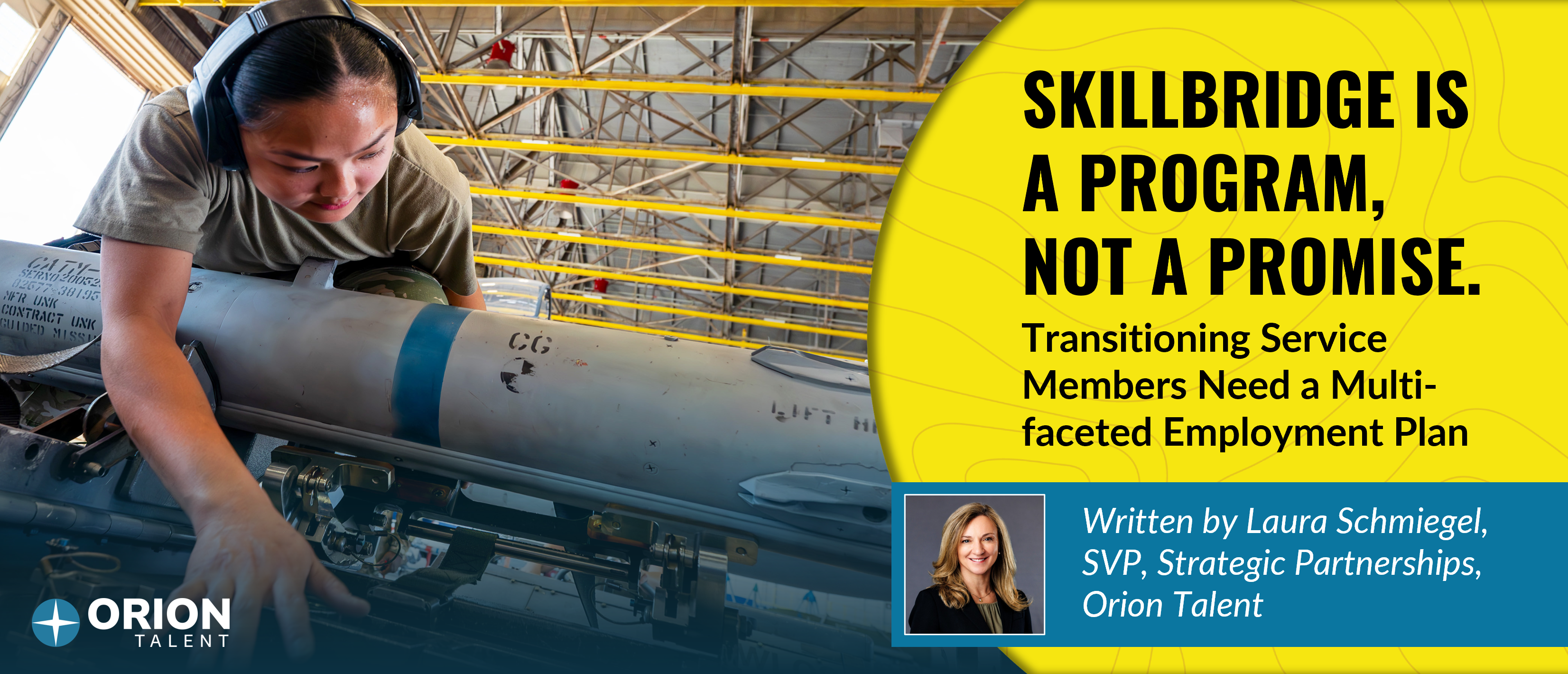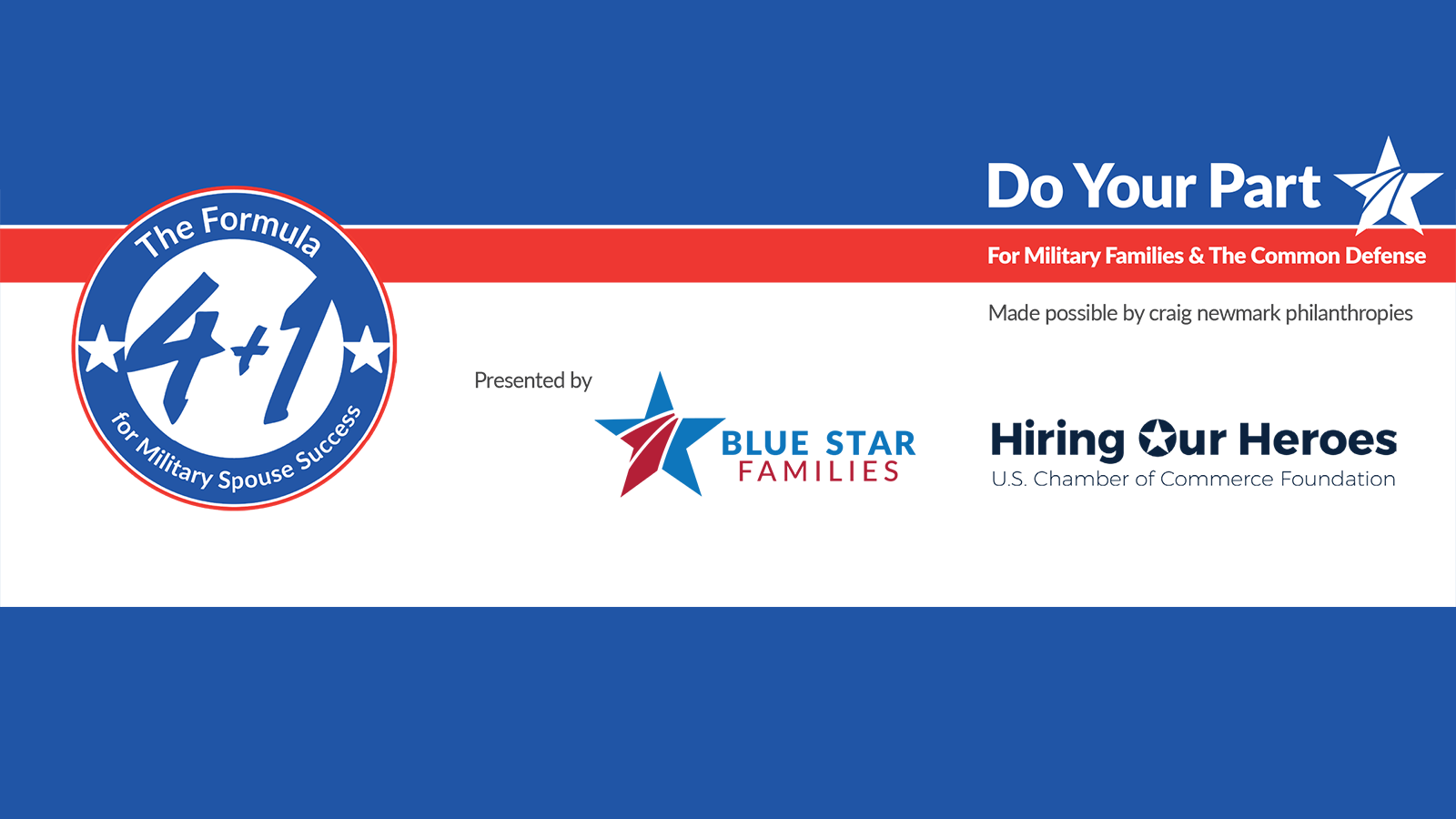
By Laura Schmiegel, SVP Strategic Partnerships, Orion Talent
For service members eyeing civilian life, the Department of Defense’s SkillBridge program appears to be a golden ticket. It offers military personnel the opportunity to participate in internships and training programs with civilian employers during their last 180 days of service, theoretically providing a seamless transition into the workforce. However, the reality is more complicated. With limited slots, competing [and priority] mission requirements, and no guarantee of a job offer at the end, SkillBridge alone is not the fail-safe transition plan many hope it to be.
A Lack of Data Makes SkillBridge Difficult to Assess
SkillBridge placements are highly competitive. The exact percentage of applicants who secure a spot is not widely published. Eligibility Requirements for SkillBridge vary by service branch, and data collection across DoD is spotty.
A recent GAO report has noted the lack of consistent reporting – and reporting requirements – about SkillBridge applicants and participants as a barrier to assessing the effectiveness of the program. Available DoD numbers show that around 20,000 transitioning servicemembers participate in SkillBridge programs each year. That figure represents only 10-15% of the total number of transitioning servicemembers per year. Even among those who do secure a placement, the job conversion rate is not tracked, and hard to measure. Anecdotal reports from veteran support groups, industry professionals and our own recruiters suggest that a significant portion of SkillBridge participants do not receive a formal job offer from their host company. That leaves many service members scrambling for employment after their service ends.
The takeaway? Relying solely on SkillBridge as a transition plan is a gamble. A failed application, an internship that doesn’t translate into a job, or a mismatch in expectations could leave a service member without stable employment post-military. Given these limitations, it is crucial for transitioning personnel to have multiple strategies for entering the civilian workforce.
A Multi-Faceted Approach Is A Necessity, Not A Luxury
For many service members, the transition from the military is their first time navigating the civilian job market. Unlike their counterparts in the private sector, they often lack established industry networks, civilian job-hunting experience, or a clear understanding of pay scales and benefits. Given this steep learning curve, relying on a single path—whether it be SkillBridge, the Transition Assistance Program (TAP), or a self-directed job search—is a risky move.
Instead, service members should pursue multiple avenues simultaneously. This includes networking with industry professionals, obtaining relevant certifications, leveraging veteran hiring programs, and working with expert recruiters who understand both military skills and the private sector.
The Role of Expert Recruiters in the Transition Process
Recruiters can play a critical role in helping veterans transition into meaningful civilian careers. However, not all recruiters are created equal. Many generalist recruiters lack an in-depth understanding of military occupations and their civilian equivalents. While they may see a “Logistics Officer” on a resume, they may not fully grasp the depth of experience in supply chain management, budgeting, or personnel leadership that comes with that role.
Veterans need recruiters who not only understand military skillsets but also have expertise in industry pay scales, job locations, and workplace cultures. The best recruiters act as advocates, helping service members translate their experience into marketable skills, negotiate competitive salaries, and find organizations where they will thrive.
Additionally, military-friendly recruiters should offer insights into high-demand fields, alternative career paths, and relocation strategies—especially since many veterans are open to moving for the right job but need to weigh the cost of living, local job markets, and family considerations.
Military Spouses Also Need A Varied Approach To Job-Seeking
While much of the conversation around military employment focuses on veterans, military spouses face significant career challenges as well. Frequent relocations due to Permanent Change of Station (PCS) moves disrupt career progress, leading to income gaps and job instability. According to the annual Military Family Lifestyle Survey by Blue Star Families, military spouses take an average of six months to secure employment after a PCS move. This lag not only impacts family finances but also leads to long-term career stagnation.
Many military spouses are not in professional careers, making job placement services even more critical. Just like transitioning service members, they would benefit from resources that can help them find remote work, portable careers, or local opportunities that match their skills and experience.
Conclusion
SkillBridge is a valuable tool, but it is not a guaranteed path to employment. The competitive nature of the program and the uncertainty of job conversion rates mean that service members must explore multiple transition strategies. Working with industry-savvy recruiters, networking extensively, and planning for contingencies are essential steps for success.
Additionally, the challenges faced by military spouses in maintaining their careers should not be overlooked. Providing them with expert job placement services can help ensure financial stability for military families and improve overall quality of life.
Transitioning out of the military is not a one-size-fits-all process. By diversifying their approach, service members and their spouses can better navigate the complexities of the civilian job market and secure long-term career success.
Archives
- March 2025
- February 2025
- October 2024
- May 2024
- March 2024
- February 2024
- January 2024
- December 2023
- November 2023
- October 2023
- September 2023
- August 2023
- July 2023
- June 2023
- May 2023
- April 2023
- March 2023
- February 2023
- January 2023
- December 2022
- November 2022
- October 2022
- September 2022
- August 2022
- July 2022
- June 2022
- May 2022
- April 2022
- March 2022
- February 2022
- January 2022
- December 2021
- November 2021
- October 2021
- September 2021
- August 2021
- July 2021
- June 2021
- May 2021
- April 2021
- March 2021
- February 2021
- January 2021
- December 2020
- November 2020
- October 2020
- September 2020
- August 2020
- July 2020
- June 2020
- May 2020
- April 2020
- March 2020
- February 2020
- January 2020
- December 2019
- November 2019
- October 2019
- September 2019
- August 2019
- July 2019
- June 2019
- May 2019
- April 2019
- March 2019
- February 2019
- January 2019
- December 2018
- November 2018
- October 2018
- September 2018
- August 2018
- July 2018
- June 2018
- May 2018
- April 2018
- March 2018
- February 2018
- January 2018
- December 2017
- November 2017
- October 2017
- September 2017
- August 2017
- July 2017
- June 2017
- May 2017
- March 2017
- February 2017
- January 2017
 RSS Feed
RSS Feed
Subscribe to Orion's Blog
Featured Blogs





.jpg)















